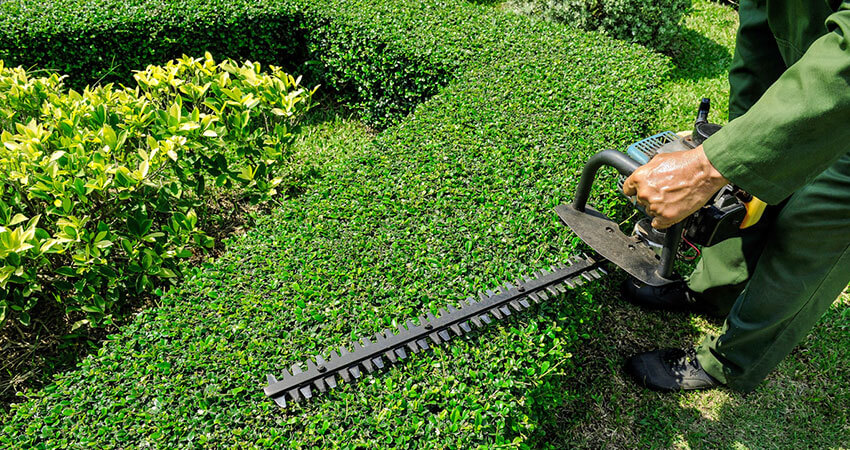Hedges are more than just decorative elements in a landscape; they contribute to privacy, windbreaks, and noise reduction. This guide delves into the essential aspects of hedge care and maintenance, focusing on the best practices for keeping your hedges healthy and looking their best.
Understanding the Importance of Regular Hedge Trimming
Regular hedge shaping is crucial for maintaining the health, shape, and aesthetic appeal of your plants. Overgrown hedges can quickly become unruly and unsightly, which may detract from the overall look of your garden. In addition to visual appeal, well-shaped hedges can also enhance the functionality of your outdoor space, providing structure and definition to your garden layout. This can be particularly beneficial in larger gardens where hedges can serve as natural dividers, creating distinct areas for relaxation, play, or even vegetable gardening.
Moreover, regular shaping encourages new growth, ensuring that your hedges remain dense and vibrant. This is particularly important for privacy hedges, which are often valued for their thick foliage. A well-maintained hedge not only provides seclusion from neighbors but can also serve as a habitat for various wildlife, including birds and beneficial insects. By fostering a healthy ecosystem within your garden, you contribute to biodiversity while enjoying the beauty of nature right at your doorstep.
Benefits of a Well-Maintained Hedge
A well-maintained hedge offers numerous advantages. Firstly, it enhances the curb appeal of your property, creating a pleasant first impression for visitors. The visual impact of neatly trimmed hedges can elevate the overall aesthetic of your home, making it more inviting and increasing its market value. Secondly, trimmed hedges can act as effective noise barriers and contribute to improved air quality by serving as natural air filters. This is particularly beneficial in urban environments where noise pollution and air quality can be significant concerns.
Additionally, maintaining your hedges can prevent issues with pests and diseases. When hedges are regularly cut back, air circulation improves, reducing the likelihood of attracting unwanted insects and ensuring that diseases do not take hold. Furthermore, regular trimming allows you to spot any potential problems early on, such as signs of infestation or disease, enabling you to take action before they escalate into more serious issues. This proactive approach not only protects your hedges but also promotes a healthier garden ecosystem overall.
Risks of Neglecting Hedge Care
If hedges are neglected, they can develop a host of problems. Overgrown hedges may become too dense, leading to poor air circulation and increased vulnerability to diseases. Moreover, large branches can become heavy and break, posing potential safety hazards. This can be particularly concerning in storm-prone areas where falling branches can cause damage to property or even injury. Regular maintenance helps mitigate these risks, ensuring that your hedges remain safe and manageable.
Neglecting your hedges can also result in increased weed growth, as the dense foliage can create a habitat for weeds to thrive. Not only can this affect the health of your hedges, but it can also make your garden appear unkempt. Weeds compete for nutrients and water, which can stifle the growth of your hedges and other plants in the vicinity. Additionally, an overgrown hedge can obstruct pathways and views, making your garden less enjoyable and functional. By committing to regular hedge trimming, you not only preserve the beauty of your outdoor space but also enhance its usability and safety.
The Basics of Hedge Trimming
Before jumping into hedge trimming, it’s important to understand the basics. Knowing when and how to trim your hedges can make all the difference in achieving a professional-looking finish. Proper trimming not only enhances the aesthetic appeal of your garden but also promotes healthy growth and longevity of your plants.
Best Time to Trim Your Hedges
The ideal time for hedge trimming depends on the species of hedge you have. In general, the best time to trim your hedges is during late winter or early spring before the new growth begins. This allows your plants to focus their energy on new growth rather than on repairing damage from pruning. Timing is crucial, as trimming too late in the season can hinder the plant’s ability to flourish.
However, some flowering hedges should be trimmed after they bloom to avoid cutting off buds. For instance, if you have lilac or forsythia hedges, trimming them immediately after their flowering period ensures that you do not sacrifice next year’s blooms. Always consider the specific requirements of your hedge type to ensure optimal growth and health. Additionally, observing the local climate and seasonal changes can help you determine the best trimming schedule for your garden.

Essential Tools for Hedge Trimming
Having the right tools makes hedge trimming easier and more effective. Essential tools include hedge shears, pruners, and electric or gas-powered hedge trimmers for larger jobs. Each tool serves a specific purpose; for example, hand shears are perfect for shaping and detailing, while power trimmers can handle more substantial growth with ease. Additionally, gloves and safety glasses are important for protecting yourself while you work.
Regular maintenance of your tools is also vital. Sharp blades ensure more precise cuts, reducing the risk of damage to your hedges and promoting healthier regrowth. Furthermore, cleaning your tools after each use helps prevent the spread of diseases between plants. It’s also beneficial to familiarize yourself with the ergonomic features of your tools, as comfortable handling can significantly reduce fatigue during larger trimming projects, allowing you to work more efficiently and effectively.
Professional Hedge Trim Services
While some homeowners prefer to tackle hedge trimming themselves, hiring a professional hedge trim service can save time and labor while ensuring top-notch results. Professional services bring expertise and experience that can elevate the quality of your hedge care.
What to Expect from a Professional Service
When you hire a professional hedge trimming service, you can expect a thorough evaluation of your hedges. Professionals will assess the health of the plants, identify potential issues, and recommend the best trimming techniques tailored to your specific hedges.
Additionally, professional services often include cleanup after the trimming process, ensuring that your yard remains tidy without the hassle of post-trim debris management.
Selecting the Right Hedge Trim Service
Choosing the right hedge trimming service is crucial. Start by seeking recommendations from friends or family, or conducting online research to identify reputable companies.
When evaluating potential services, consider their credentials, experience, and customer reviews. A good service should also provide a detailed estimate of costs, ensuring transparency regarding pricing and the scope of work involved.
DIY Hedge Care and Maintenance
For those who enjoy hands-on gardening, DIY hedge care can be rewarding. With the right knowledge and tools, you can maintain your hedges effectively and save money.
Step-by-Step Guide to Trimming Your Hedges
- Assess Your Hedges: Examine the current state of your hedges, checking for dead or diseased branches.
- Choose the Right Time: As mentioned earlier, timing is crucial for effective trimming.
- Gather Your Tools: Ensure you have all necessary tools ready before starting.
- Start Trimming: Begin at the top and work your way down. Use the proper technique for each species of hedge.
- Clean Up: Dispose of clippings properly to maintain your landscape’s aesthetic.
Safety Tips for DIY Hedge Trimming
Safety should always be a priority when trimming hedges. Always wear protective gear, including gloves and goggles, to guard against sharp branches and falling debris.
If using electric trimmers, ensure that you are familiar with the operating instructions and take precautions against tripping hazards created by cords or uneven ground. Check out more about Hedge Cutting: How Regular Trimming Can Benefit Your Garden
Long-Term Hedge Health and Sustainability
Maintaining the long-term health of your hedges goes beyond just trimming. It involves practices that promote sustainability and health among your plants.
Preventing Common Hedge Diseases
To prevent disease, monitor your hedges regularly for signs of wilting, discoloration, or unexplained leaf loss. Ensure that your hedges have adequate air circulation, which is vital for minimizing disease risk.
You can also apply organic treatments or fungicides if necessary, especially during wet weather when the incidence of disease increases. Regular maintenance, including trimming and cleaning, can mitigate many common hedge diseases.

Promoting Growth and Thickness in Your Hedges
To encourage thicker, more robust hedges, consider using fertilizers designed for shrubs before the growing season. Fertilization provides essential nutrients that may be lacking in your soil.
Additionally, ensure that your hedges receive adequate water, especially during dry spells. Employing mulching practices can also help retain moisture in the soil and supplant weeds, giving your hedges the best chance for healthy growth.
In conclusion, whether you choose to tackle hedge trimming yourself or hire a professional, regular maintenance is essential for the health and beauty of your hedges. By understanding the best practices for care, you can enjoy the many benefits that well-trimmed hedges bring to your property.
Be First to Comment